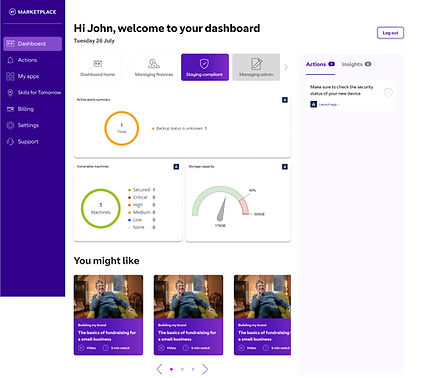
BT Business in a Box
UX/UI Case Study

Problem Statement
Managing a small business is a formidable endeavour strewn with an array of challenges. From grappling with constrained budgets and the need to wear multiple hats, to navigating the complexities of cash flow management and compliance with ever-changing regulations, small business owners find themselves in a constant juggling act. While there are a number of different management tools and offerings, it can be difficult for a small business owner to get to grips with what they need and what they don’t. As a leading digital telco, BT felt like they were well positioned to step in and develop a guided best in class experience to help businesses achieve their long term goals
The Solution
1. Personalised digital toolbox
A tailored selection of tools specially selected for business owners and their specific industry. Gives business owners an opportunity to take advantage of tools which can take their business to the next level. Options to purchase, migrate or remove tools throughout their lifecycle and provides business owners with more control, transparency and flexibility in making decisions based on their evolving needs.

2. One place to manage all tools
Access and manage all digital tools from one place with one log-in and a single bill. Supported tool migration to Nucleus further motivates business owners to consolidate their digital lives. Build a tool wishlist to keep track of emerging needs and aid meaningful expansion of the catalogue

3. A place to come back to everyday
Consolidated view of key business metrics from different tools, saving time and effort to gather analytics and cross-reference performance among tools. Customisable data modules and views to accommodate changing business priorities. Intelligent nudges supports continuous improvement in productivity and growth

4. Business profile
Proactive monitoring of the big picture inside and outside of the business with expert support, dynamic content and relevant widgets to help business owners stay ahead of their game on their digital journey as their needs evolve

Design Process
Empathize
Define
Ideate
Prototype
Test
Implementation
Understand what problems we need to solve Identify pain points for target users
Agree on objectives for the final solution. Collate existing research
Undertake ideation sessions with stakeholders Agree on the assumptions that underpin our ideas. Create hypothesis to validate our assumptions
Create low/mid fidelity designs. Build a prototype
Create testing plan. Undertake user recruitment Validate design assumptions Produce research summary reports
Create high fidelity designs Create documentation for dev team Hand-off designs for development
User Research
In order to further understand the limitations of the current landscape and the needs of SoHo and SME businesses, research and concept testing was carried out. A mix of qualitative and quantitative research was used to understand what common issues business owners faced and where other platforms fell short in attempting to solve this. Feedback was then collected on how business owners felt like these issues could best be resolved, and what features they felt they could get the most use from in order to further streamline their day to day processes. Concept testing was then carried out to get an initial impression on a potential solution and validate the overall value proposition.










User Persona
User personas were developed based on current BT customers that struggle to find ways to take their business to the next level. Many customers did not have the know how or the time to learn how to improve their business despite recognising its importance. User personas allowed us to gain an understanding of the common pain points that prevent business owners from reaching these goals and how best they could be solved.


Customer Lifecycle Development
In an effort to fully analyse the requirements a user might have, the customer lifecycle was broken down into key segments - each of which played a crucial role in developing a seamless user experience. Between working with the wider BT enterprise to ensure compliance and gathering an in-depth understanding of what users might expect, it was imperative that each stage was fully analysed for weaknesses. Segments were delegated to teams with the responsibility of ensuring a fully cohesive experience was developed that addressed user pain points and communicated a solution to business needs.
Learn journey
Buy journey
Get journey
What BIAB is What the platform
can offer
About the apps / services
Sales support
Pricing information
Create account
Add to basket
Contracts / T&Cs
Checkout
Subscription payments
Order confirmation
Onboarding
Messaging
Provisioning timeline
Expanded onboarding
Use journey
Pay journey
Support journey
Notification centre
Customer reminders
SSO Dashboard
Analytics report
Single view of apps / services
Change payment type
Bill breakdown
One bill
Cancel payments
View billing history
Paperless billing
Payment reminders
How to’s
FAQs
Cancel apps
Downgrade app usage
Request a call-back
Email support
Live chat
Lo-fi Designs






User Testing
Once initial concepts had been mocked up and approved by stakeholders, a user testing session was organised in order to validate ideas and identify room for improvement. Key areas tested were the effectiveness of the value proposition, content, visuals and vital user journeys. We also seeked to identify any pain points within the vital user journeys, as well as any areas for confusion. Questions and tasks were set up with the basis of understanding the thought process of users when consuming the content and navigating through the experience. Users were encouraged to think out loud and to be as critical as necessary.


Results were broken down into qualitative/quantitive data, key findings and most insightful quotes and compiled into a presentation for stakeholders. These results were then used to create a list of key actionable recommendations based on the feedback recieved. Recommendations were divided into minor, moderate and critical suggestions based on the impact it had on the user experience.

Final Designs












